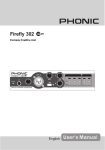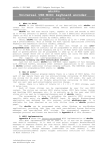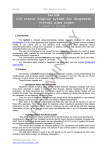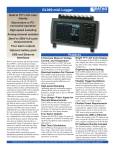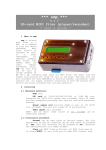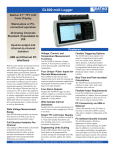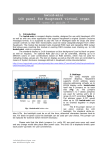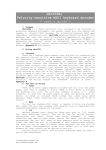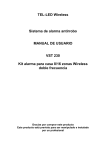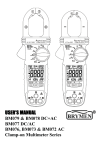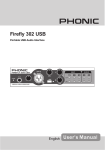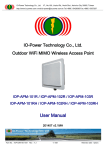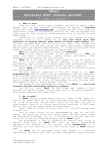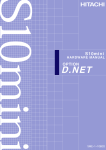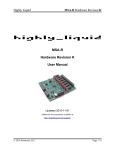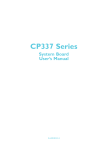Download HWce User Manual
Transcript
mpc64up © JDP’MMXIII MIDI Gadgets Boutique Inc. mpc64up Universal MIDI keyboard encoder * user’s guide * 1. What is this? mpc64up is the user-programmable successor of one of our best-selling units: mpc64xr and covers its entire functionality, adding better performance, wider capabilities within smaller size and lower cost. mpc64up is capable to scan and encode to MIDI up to 64 key contacts or general contacts configured for passive or active keying. It has 7 additional switch/button inputs as well as 8 analog inputs where potentiometers can be wired directly for allowing Continuous control by faders, pedals etc. Hence, mpc64up has the capability of encoding up to 64 + 7=71 contacts and 8 potentiometers. This is enough for most typical keyboard or control applications involving standard 5-octave keyboard and expression controls (faders, pedals). The most important capability of this unit though is its userprogrammability! Each of contacts can be programmed to send any combination of up to 32 MIDI bytes upon engaging and up to 32 MIDI bytes upon releasing. Each of potentiometers can be programmed to send up to 32 MIDI bytes upon position change where one or more of these bytes can carry the data about potentiometer's position (number between 0 and 127). The support of user-programmability allows using mpc64up for controlling virtually any MIDI-controllable software. Last but not least: mpc64up has MIDI Merge input capable of full merging, with 256-byte buffer, allowing other software applications to be cascaded to mpc64up without additional virtual merging software. The MIDI input is also used for programming MIDI events in mpc64up. 2. How it works? In mpc64up internal program memory there is a table of MIDI bytes. For each of key inputs there are two entries/strings containing 32 MIDI-bytes: one string for On event and the other string for Off event. For each of potentiometers there is an 32-byte entry/string containing 32 MIDI bytes that are sent upon each potentiometer position change. Hence, there is a table of totally 64 + 7 + 8 = 79 MIDI strings, each 32 bytes long. Each of these strings can be reprogrammed by user for any MIDI content. The string can contain MIDI status bytes, MIDI Data bytes, System and Realtime MIDI messages, etc. It is entirely up to the user what MIDI string will be sent by triggering/changing each of mpc64up inputs. The programming is done by uploading the specific MIDI string to specific table entry via mpc64up MIDI input. An special Windows-based application was designed for this purpose, called mpc64upprg.exe. It is available for free download on our site (follow links on mpc64up product page). The mpc64up can be programmed using other Windows or non-Windows applications, providing that they can send user-defined System Exclusive messages and user-defined MIDI strings. The programming sequence and messages protocol and format are described in Appendix A of this document. 3. MIDI implementation Appendix B shows the factory-programmed MIDI implementation of mpc64up. This MIDI implementation can be used as it is and can be changed by user when/if necessary. In it each of scan points triggers NoteOn/NoteOff messages on separate channel per scan matrix. MIDI Channel 1 is covered. The note range is MIDI notes 36 – 99. The additional switch/button inputs trigger Control Change messages (CC80-CC86) on MIDI channel 1. The [email protected] www.midiboutique.com mpc64up © JDP’MMX MIDI Gadgets Boutique Inc. 2 continuous/potentiometer inputs trigger continuous controller CC7 (Volume) on MIDI channels 1-8. 4. Wiring diagrams Normally, the mpc64up is used in systems with passive (GND) keying. It can be confuigured for active positive or active negative keying viltage upon request. Unless other requested the unit is supposed to work with passive keying. An unit configured for passive keying MUST NOT Be used insystems with active keying. Applying keying voltage in such unit would damage it! the keying voltage can be configured for Key inouus only!. The additional switch/button inputs cannot be configured for anything than GMD keying. The wiring diagram showing all cases of wiring can be foiund in Appendix C. The key/switch/button and potentiometer control inputs should be connected to keys/switches/buttons and potentiometers as shown on schematic. Each non-wired key/button/switch input will be read as being open contact (break). Each potentiometer input left unconnected will be read as potentiometer left in Max position. A key/button/switch input connected to GND will be read as being closed contact (make). In case potentiometer input is grounded it will be read as potentiometers left in Min position. The proper Control Change (or other programmed by user) messages for each button/switch and potentiometer will be transmitted once upon on initializing (starting up). [email protected] www.midiboutique.com mpc64up © JDP’MMX MIDI Gadgets Boutique Inc. 3 5.Technical specification. Parameter Value Unit Comment Power supply voltage Power supply current 9-12 V 50 mA Any adapter/transformer capable to source 50mA or more at 912V AC/DC can be used Number of contact inputs (scan points) 64 + 7 = 71 - Normally open or normally closed type Scan rate for contacts 300 S-1 Each key contact is being scanned 300 times per second Number of analog/potentiometer inputs 8 Scan rate or potentiometers 50 S-1 MIDI messages User-defined - MIDI channels User-defined - MIDI Merge Yes - 256 byte buffer Size 13.4x8.4x2.5 cm Approx. 5.3”x3.3”x1” Weight 70 g Approx. 2.5 oz [email protected] www.midiboutique.com 10 - 100 kOhm linear potentiometers (preferably 10kOhm) Each potentiometer is being scanned 50 times per second Up to 32-byte MIDI user-defined string per event Defined per MIDI event (single MIDI string can contain MIDI messages going on various MIDI channels mpc64up © JDP’MMX MIDI Gadgets Boutique Inc. 4 Appendix A. mpc64up – Programming Step-by-step programming sequence 1. Download the mpc64upprg.zip file from our site (www.midiboutique.com). The actual link can be found on mpc64up product page. 2. Copy and unzip the downloaded file to dedicated folder. 3. Connect computer's MIDI output to mpc64up MIDI input using standard MIDI cable. 4. Power up the mpc64up. 5. Run the unzipped mpc64upprg.exe utility. 6. Select the proper MIDI output port from 'MIDI Output' drop-down list. NOTES: Some systems may have more than one MIDI output, there could be hardware and virtual ports as well. Make sure you have selected the hardware port that is connected to mpc64up in previous steps. [email protected] www.midiboutique.com mpc64up © JDP’MMX MIDI Gadgets Boutique Inc. 5 7. Select the event you want to program. All user programmable MIDI events are listed in 'mpc64up Input/EVENT' drop-down list. There are three groups of events: ON-event for contact inputs, OFF-event for contact inputs and CHANGE events for potentiometer inputs. 8. Choose desired event content byte-by-byte by selecting byte values. NOTES: Bytes that have assigned 'Empty' will be reset to value of FF. For any event, each byte that has been assigned HEX value of FF will be ignored and won't be producing MIDI output traffic. For potentiometer events each byte that has been assigned HEX value of F6 will be replaced by potentiometer data in range 0-127 as read from potentiometer. Hence, System Reset MIDI message (HEX FF) cannot be programmed in any event and Tune Request MIDI message (HEX F6) cannot be programmed in potentiometer events. [email protected] www.midiboutique.com mpc64up © JDP’MMX MIDI Gadgets Boutique Inc. 6 9. After the MIDI string has been configured, press once the 'Send' button at the bottom. 10. Repeat steps 6 .. 9 as many times as necessary for programming desired events. 11. The unit is programmed and can be used. NOTES: The programmed MIDI strings will be permanently kept in non-volatile (powerindependent) memory and won't change until next programming. More than one mpc64up unit can be chained together and will be programmed simultaneousness as each mpc64up would retransmit whatever MIDI traffic it gets. Programming protocol The programming protocol includes three parts: Header message. This is optional 10-byte System exclusive message that only causes reset of program input queue (the 32-byte input buffer that receives the MIDI string to be programmed). During reset, all the 32 bytes of Program buffer are set to HEX value of FF. If the string to be programmed is 32 bytes long, the header message can be omitted as the input queue will be updated entirely . The format of this message is: Header message F0 00 21 7F 0D 00 xx xx xx F7 – – - - 10 bytes (all shown in HEX format) SysEx start first ID sec. ID (MGB) thd. ID (MGB) Device ID (mpc64up) Device sub-ID (message ID=0: Reset buffer) future use byte (set to 00) future use byte (set to 00) future use byte (set to 00) SysEx end The MIDI string itself. It can be between 0 and 32 bytes long. In case of 0 bytes, the MIDI string for the programmed event is considered empty and this event won't be producing any MIDI output. This has the same effect as programming HEX FF value to all 32 bytes of this [email protected] www.midiboutique.com mpc64up © JDP’MMX MIDI Gadgets Boutique Inc. 7 string. This feature is suitable for programming switches that would transmit Program change messages upon contact make and nothing upon contact break. If an MIDI string is longer than 32 bytes, only the last 32 bytes will take place. Any MIDI bytes of any order can be transmitted. The only two values that have special meaning are HEX FF (MIDI Reset) and HEX F6 (Tune Request). These are used for inserting special parameters in MIDI string. Refer to notes after the Step 8 of step-by-step programming sequence described above about these special considerations. Footer message. This is obligatory 10-byte System exclusive message that passes to mpc64up the table entry number to be programmed, and invokes the memory-write routines to copy the input buffer content to proper table entry. Footer message F0 00 21 7F 0D 01 ll mm xx F7 – - - 10 bytes (all shown in HEX format) SysEx start first ID sec. ID (MGB) thd. ID Device ID (mpc64up) Device sub-ID (message ID = 01: Store buffer) Entry number, LSB (7-bit value 00..7F) Entry number, MSB (7-bit value 00..07) Bytes in buffer (00..20) SysEx end [email protected] www.midiboutique.com mpc64up © JDP’MMX MIDI Gadgets Boutique Inc. Appendix B. mpc64up – factory MIDI implementation Keys Key# Control type MIDI message on make MIDI message on break MIDI channel Comment 1 momentary contact/switch NoteOn #36 NoteOff #36 1 2 momentary contact/switch NoteOn #37 NoteOff #37 1 3 momentary contact/switch NoteOn #38 NoteOff #38 1 4 momentary contact/switch NoteOn #39 NoteOff #39 1 5 momentary contact/switch NoteOn #40 NoteOff #40 1 6 momentary contact/switch NoteOn #41 NoteOff #41 1 7 momentary contact/switch NoteOn #42 NoteOff #42 1 8 momentary contact/switch NoteOn #43 NoteOff #43 1 9 momentary contact/switch NoteOn #44 NoteOff #44 1 10 momentary contact/switch NoteOn #45 NoteOff #45 1 11 momentary contact/switch NoteOn #46 NoteOff #46 1 12 momentary contact/switch NoteOn #47 NoteOff #47 1 13 momentary contact/switch NoteOn #48 NoteOff #48 1 14 momentary contact/switch NoteOn #49 NoteOff #49 1 15 momentary contact/switch NoteOn #50 NoteOff #50 1 16 momentary contact/switch NoteOn #51 NoteOff #51 1 17 momentary contact/switch NoteOn #52 NoteOff #52 1 18 momentary contact/switch NoteOn #53 NoteOff #53 1 19 momentary contact/switch NoteOn #54 NoteOff #54 1 20 momentary contact/switch NoteOn #55 NoteOff #55 1 21 momentary contact/switch NoteOn #56 NoteOff #56 1 22 momentary contact/switch NoteOn #57 NoteOff #57 1 23 momentary contact/switch NoteOn #58 NoteOff #58 1 24 momentary contact/switch NoteOn #59 NoteOff #59 1 25 momentary contact/switch NoteOn #60 NoteOff #60 1 26 momentary contact/switch NoteOn #61 NoteOff #61 1 27 momentary contact/switch NoteOn #62 NoteOff #62 1 28 momentary contact/switch NoteOn #63 NoteOff #63 1 29 momentary contact/switch NoteOn #64 NoteOff #64 1 30 momentary contact/switch NoteOn #65 NoteOff #65 1 31 momentary contact/switch NoteOn #66 NoteOff #66 1 32 momentary contact/switch NoteOn #67 NoteOff #67 1 33 momentary contact/switch NoteOn #68 NoteOff #68 1 34 momentary contact/switch NoteOn #69 NoteOff #69 1 35 momentary contact/switch NoteOn #70 NoteOff #70 1 36 momentary contact/switch NoteOn #71 NoteOff #71 1 37 momentary contact/switch NoteOn #72 NoteOff #72 1 38 momentary contact/switch NoteOn #73 NoteOff #73 1 39 momentary contact/switch NoteOn #74 NoteOff #74 1 40 momentary contact/switch NoteOn #75 NoteOff #75 1 41 momentary contact/switch NoteOn #76 NoteOff #76 1 42 momentary contact/switch NoteOn #77 NoteOff #77 1 43 momentary contact/switch NoteOn #78 NoteOff #78 1 [email protected] www.midiboutique.com 8 mpc64up © JDP’MMX MIDI Gadgets Boutique Inc. 44 momentary contact/switch NoteOn #79 NoteOff #79 1 45 momentary contact/switch NoteOn #80 NoteOff #80 1 46 momentary contact/switch NoteOn #81 NoteOff #81 1 47 momentary contact/switch NoteOn #82 NoteOff #82 1 48 momentary contact/switch NoteOn #83 NoteOff #83 1 49 momentary contact/switch NoteOn #84 NoteOff #84 1 50 momentary contact/switch NoteOn #85 NoteOff #85 1 51 momentary contact/switch NoteOn #86 NoteOff #86 1 52 momentary contact/switch NoteOn #87 NoteOff #87 1 53 momentary contact/switch NoteOn #88 NoteOff #88 1 54 momentary contact/switch NoteOn #89 NoteOff #89 1 55 momentary contact/switch NoteOn #90 NoteOff #90 1 56 momentary contact/switch NoteOn #91 NoteOff #91 1 57 momentary contact/switch NoteOn #92 NoteOff #92 1 58 momentary contact/switch NoteOn #93 NoteOff #93 1 59 momentary contact/switch NoteOn #94 NoteOff #94 1 60 momentary contact/switch NoteOn #95 NoteOff #95 1 61 momentary contact/switch NoteOn #96 NoteOff #96 1 62 momentary contact/switch NoteOn #97 NoteOff #97 1 63 momentary contact/switch NoteOn #98 NoteOff #98 1 64 momentary contact/switch NoteOn #99 NoteOff #99 1 MIDI message on make MIDI message on break MIDI channel Comment 1 momentary contact/switch CC#80 On CC#80 Off 1 2 momentary contact/switch CC#81 On CC#81 Off 1 3 momentary contact/switch CC#82 On CC#82 Off 1 4 momentary contact/switch CC#83 On CC#83 Off 1 5 momentary contact/switch CC#84 On CC#84 Off 1 6 momentary contact/switch CC#85 On CC#85 Off 1 7 momentary contact/switch CC#86 On CC#86 Off 2 Buttons Button# Control type Potentiometers Pot# Control type MIDI message on change potentiometer or control CC7 (Volume) 1 voltage 0 .. +5V potentiometer or control 2 voltage 0 .. +5V potentiometer or control 3 voltage 0 .. +5V potentiometer or control 4 voltage 0 .. +5V potentiometer or control 5 voltage 0 .. +5V potentiometer or control 6 voltage 0 .. +5V potentiometer or control 7 voltage 0 .. +5V 8 potentiometer or control [email protected] www.midiboutique.com MIDI channel Comment 1 CC7 (Volume) 2 CC7 (Volume) 3 CC7 (Volume) 4 CC7 (Volume) 5 CC7 (Volume) 6 CC7 (Volume) 7 CC7 (Volume) 8 9 mpc64up © JDP’MMX voltage 0 .. +5V [email protected] www.midiboutique.com MIDI Gadgets Boutique Inc. 10 mpc64up © JDP’MMX MIDI Gadgets Boutique Inc. 11 Appendix C. Wiring diagram NOTE: More detailed copy of this diagram is available on our site in .pdf format! [email protected] www.midiboutique.com











